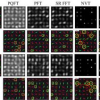Free Online Productivity Tools
i2Speak
i2Symbol
i2OCR
iTex2Img
iWeb2Print
iWeb2Shot
i2Type
iPdf2Split
iPdf2Merge
i2Bopomofo
i2Arabic
i2Style
i2Image
i2PDF
iLatex2Rtf
Sci2ools
CVPR
2008
IEEE
2008
IEEE
Spatio-temporal Saliency detection using phase spectrum of quaternion fourier transform
Salient areas in natural scenes are generally regarded as the candidates of attention focus in human eyes, which is the key stage in object detection. In computer vision, many models have been proposed to simulate the behavior of eyes such as SaliencyToolBox (STB), Neuromorphic Vision Toolkit (NVT) and etc., but they demand high computational cost and their remarkable results mostly rely on the choice of parameters. Recently a simple and fast approach based on Fourier transform called spectral residual (SR) was proposed, which used SR of the amplitude spectrum to obtain the saliency map. The results are good, but the reason is questionable. In this paper, we propose it is the phase spectrum, not the amplitude spectrum, of the Fourier transform that is the key in obtaining the location of salient areas. We provide some examples to show that PFT can get better results in comparison with SR and requires less computational complexity as well. Furthermore, PFT can be easily extended from a...
Amplitude Spectrum | Computer Vision | CVPR 2008 | Fourier Transform | Phase Spectrum | Quaternion Fourier Transform | Two-dimensional Fourier Transform |
| Added | 12 Oct 2009 |
| Updated | 28 Oct 2009 |
| Type | Conference |
| Year | 2008 |
| Where | CVPR |
| Authors | Chenlei Guo, Qi Ma, Liming Zhang |
Comments (0)

